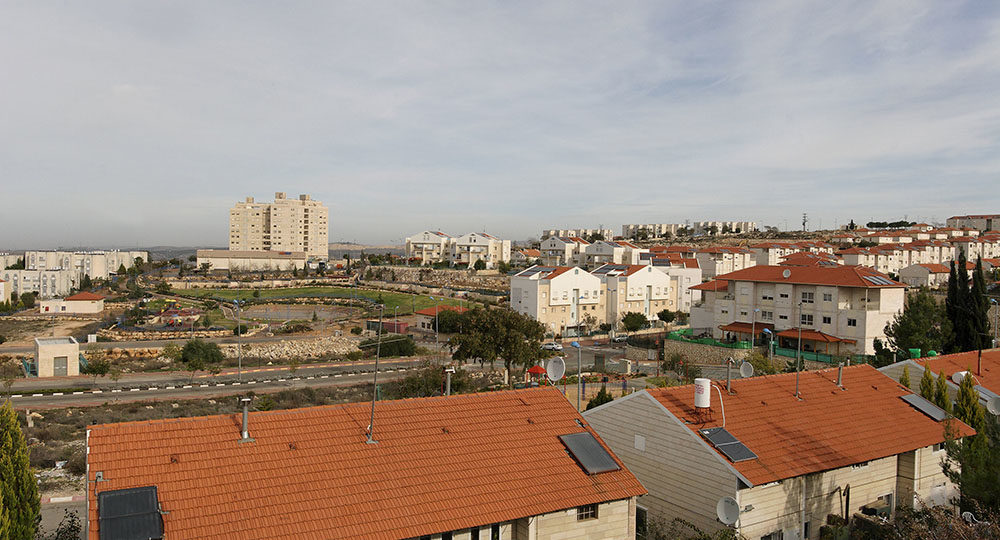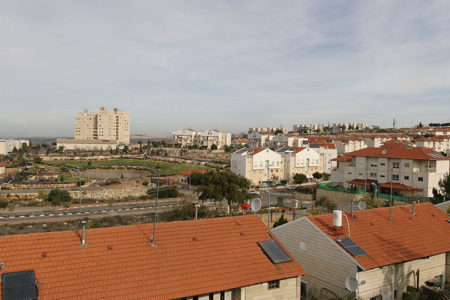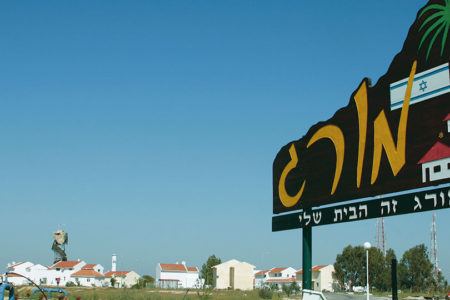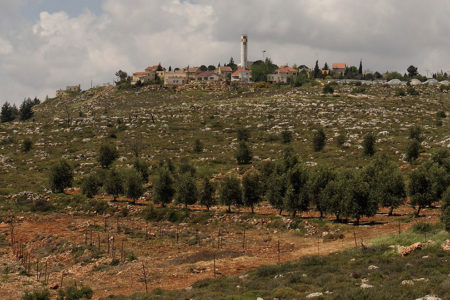Ariel: City of Visionaries
When 40 families stood atop a craggy mountain overlooking the wilderness of Samaria in 1978 and scanned the barren wasteland that would become their home, it seemed as though they were reliving a scene from Israel’s past.
They were like the early Zionist pioneers whose vision, courage, and tenacity drove them to return to their ancient homeland to clear malaria-infested swamps that Arabs had happily sold to them for outrageous prices.
In this case, there were no swamps. But there was back-country: 7,500 acres of lifeless land that was never registered as private during the Ottoman, British, or Jordanian occupations of Samaria, which spanned hundreds of years.
Looking at the beautiful city of Ariel today, with its cultural activities, schools, university, and population of 20,000, you would never know it began, as American Friends of Ariel put it, “with two tents dropped from helicopters onto the rocky, soilless ground the Arabs referred to as the ‘hill of death.’”
But the difficult terrain did not deter the 40 families who had a dream and a desire to tough it out in the land of their fathers. They wanted to create a better world for their people, marked by diversity and cooperation with their Arab neighbors.
Most of the world refers to Samaria as the “West Bank” (meaning the west bank of Jordan) and to Ariel as a “settlement.” Yet Samaria does not belong to Jordan, and the word settlement hardly fits Ariel’s size as a bustling city or takes into account its deep Jewish roots in the land God gave to the children of Abraham, Isaac, and Jacob.
The Jewish presence in and around the city dates back to biblical times. Joshua’s tomb rests in the nearby town of Kifl Hares.
For centuries the land lay fallow, changing hands between the Roman, Muslim, Ottoman, and British empires. But in 1978, under the leadership of 36-year-old Ron Nachman, 40 families laid the framework for the city whose name means “lion of God.” They were pioneers, willing to withstand the rugged conditions of no roads, no running water, and no electricity. Water had to be brought in by tankers, and electricity had to be produced by generators.
Yet they believed Genesis 17:8: “I give to you and your descendants after you . . . all the land of Canaan, as an everlasting possession; and I will be their God.” Perhaps they also knew Jeremiah 31:4–5:
Again I will build you, and you shall be rebuilt, O virgin of Israel! You shall again be adorned with your tambourines, and shall go forth in the dances of those who rejoice. You shall yet plant vines on the mountains of Samaria.
Born in Tel Aviv in 1942 when Israel was still under British control, Nachman understood the area’s strategic importance to a country surrounded by enemies. As Ariel grew, he carefully shepherded it as mayor for nearly three decades until succumbing to cancer in 2013.
In some ways, Ron Nachman was like a modern Theodor Herzl, the father of Zionism. Herzl had articulated the Jewish people’s need to begin looking homeward in the 1800s when he saw anti-Semitism rising in Europe. For about 2,000 years, the Jews had been a migrant minority in countries that often shifted from tolerance to indignation when incited by politicians who needed scapegoats for cultural and economic failures.
Scoffers mocked Herzl when he declared, “If you will it, it is no dream.” Unlike him, they did not see the clouds gathering that would immerse civilization in the clutches of death and force the Jewish people into the center of the terror.
The early immigrants who bore the heat, sickness, and deprivation to tame the wilderness were not zealous adventurers. They were hard-working men and women, planting the flag in the sands of what would become, not simply a dream, but a central factor in the survival of the Jewish people.
Ron Nachman knew the importance of establishing a city on the high, craggy mountaintop in Samaria after the 1967 Six-Day War. When the Yesha Council in Israel paid tribute to him after his death, it declared,
Ron Nachman was…a Zionist settlement pioneer in his body and soul and an unstoppable builder of the Land of Israel. Ron Nachman’s huge enterprise, the city of Ariel, will forever remain, in his memory.
Ariel is located halfway between the Mediterranean Sea and the Jordan River. It is considered the capital of Samaria, built alongside the ruins of an ancient Israelite city that dates back more than 3,000 years.
The Israeli government approved Ariel’s establishment upon state land near the village of Haris. The land had never been populated, so no Arabs were displaced.
Israel has always desired to live in peace with its neighbors, but the feeling has not been mutual. The Arabs devastated Hebron in 1929 when they slaughtered 64 Jewish people during the Arab riots of the 1920s. Hebron is where Abraham purchased a burial plot for his beloved wife, Sarah, making it the oldest Jewish community in the world (Gen. 23).
King David was anointed in Hebron and reigned from there for seven years before moving the nation’s capital to Jerusalem. The city retained a Jewish presence even through tempestuous times, until the massacre in 1929 during British rule. After that, the Jews were effectively locked out of Hebron, as well as other areas they cultivated and developed, until May 14, 1948, when the battered survivors of Hitler’s madness were granted statehood in the land of their fathers.
But the struggle to survive did not end when Israel received its independence from the international powers. The Arabs initiated a war of annihilation and occupied much of the land originally designated for a Jewish home-land until the war of liberation in 1967, which reunified Jerusalem and again gave the Jewish people access to their holiest sites.
However, what Israel’s enemies could not accomplish on the battlefield, they are trying to accomplish through politics. For decades they have been waging a vicious propaganda war to delegitimize the Jewish state. Today, despite Israel’s immense progress developing goods and services that benefit the entire world, left-wingers and others question the legality of its existence.
Post-Zionism has emerged. It is a movement within Israel, conceived mainly by academic elitists and intellectual, social reconstructionists, that repudiates what men like Ron Nachman and Theodor Herzl stood for.
Meyrav Wurmser, an Israeli-American scholar and cofounder of the Middle East Media Research Institute (MEMRI), succinctly described the core of the ideology in The Middle East Quarterly:
Post-Zionism undermines Israel’s soul and reduces its will for self-defense. No longer are Israelis regularly subjected to calls just from the outside world to regard surrender, cowardice, and flight in the face of threat as virtuous; now these appeals come also from within. In contrast, honor and defense are viewed as offensive nationalism.1
In other words, Israel’s very existence is deemed unjustifiable. And unfortunately, many young Israelis are said to be warming to the idea.
While post-Zionists tear away at Israel from within, Israel’s enemies from without are planning a new holocaust. They make no apology for their intentions, announcing them almost daily.
Yet most Western leaders blithely pursue placation based on the fantasy that surrender is the path to peace. They do not seem to care that Arab Islamists refuse even to recognize Israel’s right to exist. In fact, the Arabs have not wavered on that point since the Jewish state was established: “No recognition, no negotiations, no peace” has been their mantra. And though Iran’s first priority is Israel’s destruction, Westerners prefer to believe the country can be talked into civility.
Strangely enough, Iran has found allies in America, another country it hopes to destroy. They belong to the anti-Semitic wing of the radical left. Some are Replacement Theology advocates; others belong to the Boycott, Divestment and Sanctions Movement (BDS) in denominations and academic institutions that equate Israel with the old apartheid South Africa.
Ironically, BDSers preach the Arab-Muslim message of “no recognition, no negotiations, no peace” and sometimes get involved in attacking Jewish student centers on college campuses, smearing swastikas on synagogue walls, and assaulting Jewish people—all of which are reminiscent of the early days of Nazi Germany.
There is no such thing as national strength through weakness and surrender. It is a concept that creates mayhem and chaos on a number of fronts, particularly in the Middle East and Africa, and reaps a terrible harvest of victims, including Christians and Jews.
When Ron Nachman and the Ariel 40 stepped onto the rock-strewn barrenness that would become the metropolis of today, they were not throwbacks to a bygone era. They discerned the times and reinvigorated the practical Zionism needed for national survival. In a very few years, Jewish people would be seeing the world through a different window. Their utopian dream of peace was not to be, and a grim reality was about to reemerge.
A massive invasion of Muslims, including wildly radical jihadists, is refashioning much of Europe and persuading many Jewish people that, again, it’s time to leave.
Jewish Agency head Natan Sharansky estimates 250,000 Jewish people will move to Israel from France alone in the next 20 years.2
In the Middle East, the heralded Arab Spring that began in 2010 faded into a winter of failed illusion. It produced destabilizing bloodbaths dedicated to ridding the region of Jews, Christians, and Israel.
Today an alarming turn in the American administration away from Israel further clouds the future. Instead of backing its only stable ally in the Middle East, America is pandering to the United Nations and attempting to make Israel an indefensible island imprisoned within the fragile armistice lines of 1948.
With anti-Semitism reemerging as a force to be reckoned with, the need is obvious for a stable Jewish homeland with secure borders, able to accommodate those who would end up displaced without it. Anti-Semitism is like a cancer that cannot be denied, wished away, or ignored. Europe tried all three 70 years ago, and the result was a malignancy of catastrophic proportions.
Ariel stands as a testimony to visionaries who saw the need and did something about it. The Jewish state’s existence is an absolute necessity. And Ron Nachman and the Ariel 40 endure as pioneers of a model that should be replicated many times over.
ENDNOTES
- Meyrav Wurmser, “Can Israel Survive Post-Zionism?” The Middle East Quarterly, March 1999 <meforum.org/469/can-israel-survive-post-zionism>.
- “French PM: France without Jews would be a failure,” The Times of Israel, January 11, 2015 <timesofisrael.com/french-pm-france-without-jews-would-be-a-failure>.









This article did good for my heart, I’ve heard so many negative things about Israel in the last 2decades and about the Zionist movement it gets confusing but your article brings me back to when I was first saved and made aware that God has brought His people back to the land he gave them thousands of years ago and this lines up with the scriptures old & New Testament.
God bless you for sharing this about Ariel and the amazing thing these people did to turn the dry wasteland into an oasis. A testimony to God and His people and His word!!